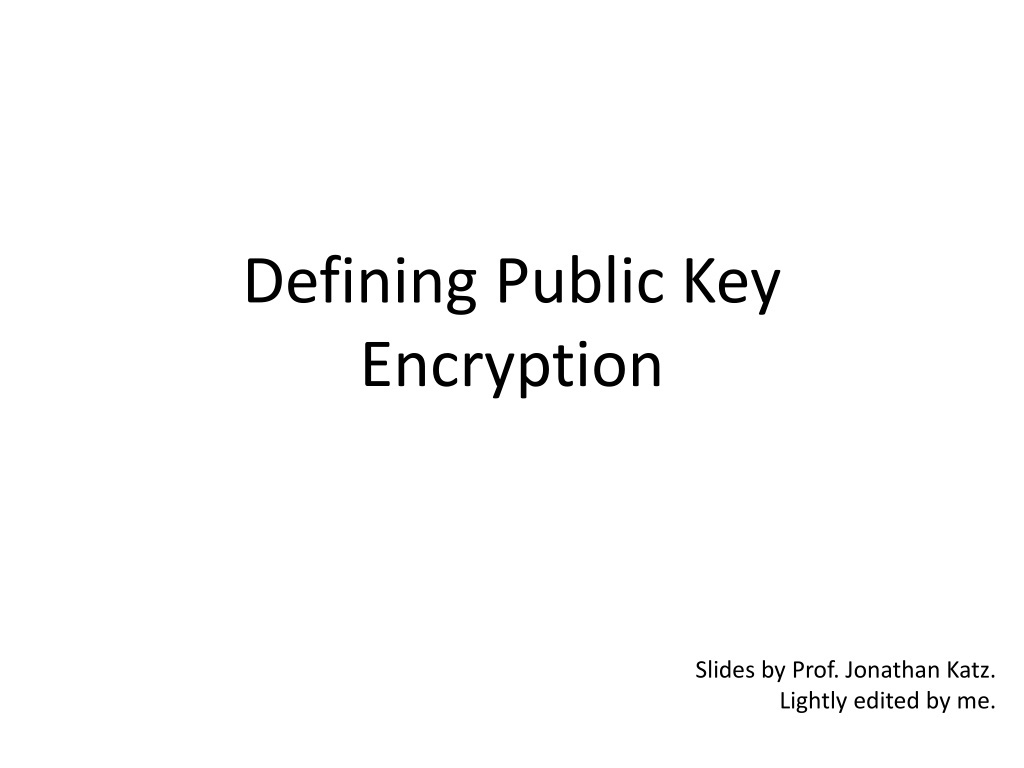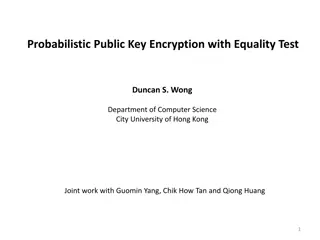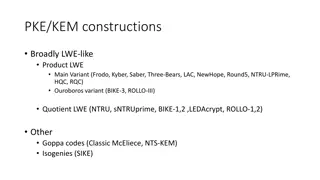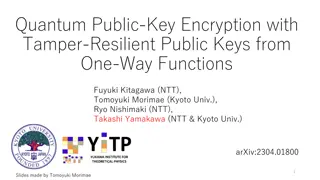
Understanding Public Key Encryption and Key Distribution
Explore the concepts of public key encryption, secure key distribution, and how it addresses the limitations of private-key cryptography. Discover the fundamental principles and mechanisms behind asymmetric cryptography for secure communication in digital systems.
Download Presentation

Please find below an Image/Link to download the presentation.
The content on the website is provided AS IS for your information and personal use only. It may not be sold, licensed, or shared on other websites without obtaining consent from the author. Download presentation by click this link. If you encounter any issues during the download, it is possible that the publisher has removed the file from their server.
E N D
Presentation Transcript
Defining Public Key Encryption Slides by Prof. Jonathan Katz. Lightly edited by me.
Review: private-key setting Two (or more) parties who wish to securely communicate share a uniform, secret key k in advance Same key k used for sending or receiving Either party can send or receive If multiple parties share a key, no way to distinguish them from one another based on the key Secrecy of k is critical No security if attacker knows k
The public-key setting One party generates a pair of keys: public key pk and private key sk Public key is widely disseminated Private key is kept secret, and shared with no one Private key used by the party who generated it; public key used by anyone else Also called asymmetric cryptography Security must hold even if the attacker knows pk 3
Public-key distribution I pk pk pk pk, sk
Public-key distribution II pk pk, sk
Public-key distribution Previous figures (implicitly) assume parties are able to obtain correct copies of each others public keys I.e., the attacker is passive during key distribution We will revisit this assumption later 6
Primitives Private-key setting Public-key setting Private-key encryption Public-key encryption Secrecy Message Digital signature schemes Integrity authentication codes 7
How does this address the drawbacks of private-key crypto ? Key distribution Public keys can be distributed over public (but authenticated) channels Key management in system of N users Each user stores 1 private key and N-1 publickeys; only N keys overall Public keys can be stored in a central, public directory Applicability to open systems Even parties who have no prior relationship can find each others public keys and use them 8
Public-key vs. private-key crypto Public-key cryptography is strictly stronger than private-key cryptography Parties who wish to securely communicate could simply each generate public/private keys and then share them with each other Use appropriate key depending on who is sending or receiving
Why study private-key crypto? Public-key crypto is roughly 2-3 orders of magnitude slower than private-key crypto Also 2-10 higher communication If private-key crypto is an option, better to use it! As we will see, private-key cryptography is used for efficiency even in the public-key setting 10
Public-key encryption pk pk c pk pk, sk c Encpk(m) m = Decsk(c)
Public-key encryption A public-key encryption scheme consists of three PPT algorithms: Gen: key-generation algorithm that on input 1n outputs (pk, sk) Enc: encryption algorithm that on input pk and a message m outputs a ciphertext c Dec: decryption algorithm that on input sk and a ciphertext c outputs a message m or an error For all m and (pk, sk) output by Gen, Decsk(Encpk(m)) = m 12
Notes on the definition No encryption oracle?! Encryption oracle redundant in public-key setting No perfectly secret public-key encryption No deterministic public-key encryption scheme can be CPA-secure CPA-security implies security for encrypting multiple messages (as in the private-key case) 13
Chosen-ciphertext attacks c pk pk, sk c Encpk(m) c m
Chosen-ciphertext attacks Chosen-ciphertext attacks are arguably even a greater concern in the public-key setting Attacker might be a legitimate sender Easier for attacker to obtain full decryptions of ciphertexts of its choice Related concern: malleability I.e., given a ciphertext c that is the encryption of an unknown message m, might be possible to produce ciphertext c that decrypts to a related message m This is also undesirable in the public-key setting 15
Chosen-ciphertext attacks Can define CCA-security for public-key encryption by analogy to the definition for private-key encryption See book for details 16















